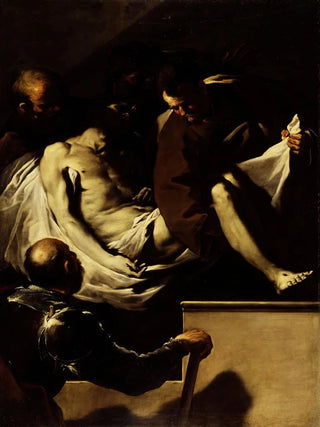Art print | Entombment of Christ - Luca Giordano


View from behind

Frame (optional)
Art print of the Entombment of Christ by Luca Giordano – Captivating introduction
Luca Giordano's "Entombment of Christ" is a work that transcends the simple framework of religious painting to establish itself as a true masterpiece of Baroque art. This painting, both poignant and dynamic, evokes themes of pain and resurrection—universal themes that deeply touch the human soul. Contemplating this piece, the viewer is immediately transported into a scene imbued with gravity and beauty, where each character, each gesture, seems charged with palpable emotion. Giordano's narrative power draws the eye and invites reflection on the human condition, suffering, and hope.
Style and uniqueness of the work
Giordano's style is characterized by an exceptional mastery of light and color, hallmarks of Italian Baroque. In the "Entombment of Christ," he employs striking contrasts between shadow and light to emphasize the three-dimensionality of the figures. The drapery of the garments, rendered with an almost tangible fluidity, reveals the artist's technical virtuosity. The expressions of the characters, alternately despairing and serene, create a dramatic tension that captures attention. The work also stands out for its dynamic composition, where diagonal lines guide the viewer's gaze across the scene, enhancing the movement and intensity of the captured moment. Giordano manages to create an atmosphere that is both intimate and grandiose, where every detail contributes to the whole, making this work unique in the panorama of Baroque art.
The artist and his influence
Luca Giordano, born in Naples in 1634, is one of the most emblematic artists of the 17th century. Influenced by masters such as Caravaggio and Rubens, he develops a personal style that combines classical rigor with Baroque expressiveness. His prolific career saw him create numerous works for churches and palaces, but it is his ability to capture human emotions that truly sets him apart. Giordano successfully established himself on the European artistic scene, influencing generations of artists after him. His innovative approach to pictorial storytelling and his bold use of color

Matte finish

View from behind

Frame (optional)
Art print of the Entombment of Christ by Luca Giordano – Captivating introduction
Luca Giordano's "Entombment of Christ" is a work that transcends the simple framework of religious painting to establish itself as a true masterpiece of Baroque art. This painting, both poignant and dynamic, evokes themes of pain and resurrection—universal themes that deeply touch the human soul. Contemplating this piece, the viewer is immediately transported into a scene imbued with gravity and beauty, where each character, each gesture, seems charged with palpable emotion. Giordano's narrative power draws the eye and invites reflection on the human condition, suffering, and hope.
Style and uniqueness of the work
Giordano's style is characterized by an exceptional mastery of light and color, hallmarks of Italian Baroque. In the "Entombment of Christ," he employs striking contrasts between shadow and light to emphasize the three-dimensionality of the figures. The drapery of the garments, rendered with an almost tangible fluidity, reveals the artist's technical virtuosity. The expressions of the characters, alternately despairing and serene, create a dramatic tension that captures attention. The work also stands out for its dynamic composition, where diagonal lines guide the viewer's gaze across the scene, enhancing the movement and intensity of the captured moment. Giordano manages to create an atmosphere that is both intimate and grandiose, where every detail contributes to the whole, making this work unique in the panorama of Baroque art.
The artist and his influence
Luca Giordano, born in Naples in 1634, is one of the most emblematic artists of the 17th century. Influenced by masters such as Caravaggio and Rubens, he develops a personal style that combines classical rigor with Baroque expressiveness. His prolific career saw him create numerous works for churches and palaces, but it is his ability to capture human emotions that truly sets him apart. Giordano successfully established himself on the European artistic scene, influencing generations of artists after him. His innovative approach to pictorial storytelling and his bold use of color






